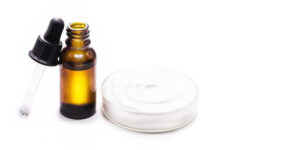Mandelic acid is an alpha hydroxy acid (AHA) that is used in skincare for its exfoliating and rejuvenating properties. It offers several benefits for the skin and is suitable for various skin types.
Mandelic acid acts as a chemical exfoliant, helping to remove dead skin cells from the surface of the skin. This process promotes skin renewal, improves texture, and can lead to a smoother and brighter complexion. Mandelic acid is considered one of the milder AHAs, making it suitable for individuals with sensitive or easily irritated skin.
It exfoliates more gently than some other AHAs, such as glycolic acid. Mandelic acid’s exfoliating properties can help unclog pores, reduce the formation of blackheads and whiteheads, and prevent breakouts. It is often used in products targeting acne-prone skin. Regular use of mandelic acid can help reduce the appearance of fine lines and wrinkles by promoting collagen production and skin renewal. It can contribute to a more youthful complexion.

Mandelic acid can assist in addressing hyperpigmentation concerns, including dark spots, melasma, and uneven skin tone. It promotes the shedding of pigmented skin cells for a more even complexion.
Mandelic acid has mild antibacterial properties, which can be beneficial for individuals with acne-prone skin. It can help control the growth of acne-causing bacteria. Mandelic acid may help repair and improve skin damaged by sun exposure.
Read Also: The Surprising Benefits of Glycolic Acid
It can reduce the appearance of sunspots and contribute to a more even skin tone. Mandelic acid has humectant properties, which means it can help the skin retain moisture. It is less likely to cause excessive dryness compared to some other AHAs. Mandelic acid is generally safe for individuals with darker skin tones (Fitzpatrick skin types III to VI) and is less likely to cause post -inflammatory hyperpigmentation, a common concern with other AHAs.
Mandelic acid can be combined with other skincare ingredients, such as niacinamide, hyaluronic acid, or antioxidants, to address multiple skincare concerns effectively.
When using mandelic acid in your skincare routine:
Start Slowly:
If you are new to mandelic acid, begin with lower concentrations and gradually increase usage as your skin becomes accustomed.
Follow Product Instructions:
Read and follow the instructions provided with the product carefully, including usage frequency and precautions.
Use Sunscreen:
Always wear sunscreen during the day when using products with Mandelic acid, as it can increase skin sensitivity to the sun.
Discontinue If Irritation Occurs:
If you experience severe or prolonged irritation, redness, or any other adverse reactions, stop using the product immediately and consult a healthcare professional. Mandelic acid can be a valuable addition to a skincare routine, especially for those looking for gentle exfoliation and treatment of acne, hyperpigmentation, and fine lines.
However, individual responses to skincare ingredients can vary, so always pay close attention to your skin’s needs and adjust your routine accordingly when using mandelic acid or any other active ingredient.
Forms of Mandelic acid for Skin:
Mandelic acid is available in various forms in skincare products to cater to different skin concerns and preferences. Mandelic Acid Serums: Mandelic acid serums contain a higher concentration of the acid and are typically used as targeted treatments for specific skin concerns.
They can be applied directly to areas of concern or used on the entire face. Some facial cleansers incorporate mandelic acid as an exfoliating ingredient. These cleansers offer a convenient way to incorporate mandelic acid into your daily skincare routine, as they provide mild exfoliation during cleansing.
Mandelic acid toners are designed to balance the skin’s pH and provide gentle exfoliation. They are used after cleansing to prepare the skin for subsequent skincare products and enhance overall skin texture.
Mandelic acid masks are formulated to provide a more intensive treatment compared to daily use products. They are typically used once or twice a week to promote skin renewal, improve skin tone, and achieve a brighter complexion.

Pre-soaked pads or wipes containing mandelic acid provide a convenient and controlled way to apply the acid to the skin. They are often used for quick spot treatments or on-the-go exfoliation. Some spot treatments contain mandelic acid as a key ingredient. These products are used for targeted treatment of acne breakouts or areas with hyperpigmentation.
Mandelic acid is not limited to facial skincare. It is also used in body lotions, creams, and scrubs to provide exfoliation and improve skin texture on areas such as the arms, legs, and back. Mandelic acid is used in professional chemical peels administered by dermatologists or licensed skincare professionals. These peels offer a more significant exfoliation and can address various skin concerns, including pigmentation issues and signs of aging.
Precautions for using Mandelic acid:
Using mandelic acid in your skincare routine can provide numerous benefits, but it’s essential to take certain precautions to ensure safe and effective usage.
Here are some precautions to keep in mind when using mandelic acid on your skin:
Before applying a product containing mandelic acid to your face or a larger area of skin, perform a patch test.
Read Also: Uncovering the Hidden Powers of Vitamin C
Apply a small amount of the product to a discreet area, such as the inside of your wrist or behind your ear. Wait 24-48 hours to check for any adverse reactions, such as redness, itching, or irritation.

If you’re new to mandelic acid or have sensitive skin, begin with products containing lower concentrations of the acid. Gradually increase the concentration or frequency of use as your skin becomes accustomed.
Read and follow the instructions provided with the product carefully. This includes information on how often to use the product, the recommended application method, and any precautions or warnings.
Mandelic acid can make your skin more sensitive to UV radiation, so it’s crucial to apply a broad-spectrum sunscreen with an SPF of at least 30 every morning, even on cloudy days.
Reapply sunscreen throughout the day if you’re outdoors. Using too much mandelic acid or using it too frequently can potentially lead to skin irritation, redness, or dryness.
It’s essential to adhere to the recommended usage frequency and not over-exfoliate your skin. Avoid using multiple exfoliating products simultaneously, as this can lead to over-exfoliation and potential skin irritation.
If you want to incorporate other exfoliants, do so cautiously and consider consulting a dermatologist for guidance.
If you have specific skin concerns or conditions, such as severe acne, persistent hyperpigmentation, or sensitive skin, it’s advisable to consult a dermatologist. They can provide personalized recommendations and may suggest stronger treatments if necessary.

If you experience severe or prolonged irritation, redness, or any other adverse reactions, stop using the mandelic acid product immediately and consult a healthcare professional. Achieving noticeable results with mandelic acid takes time and consistency.
It may take several weeks to months before you see significant improvements in skin texture, tone, and brightness. Be patient and continue using the product as directed. Pay close attention to how your skin responds to mandelic acid. If you notice any unusual or persistent reactions, adjust your skincare routine accordingly and seek professional advice if needed.
By following these precautions and incorporating mandelic acid into your skincare routine responsibly, you can enjoy its exfoliating and rejuvenating benefits while minimizing the risk of irritation or adverse reactions. Individual responses to skincare ingredients can vary, so always prioritize your skin’s health and needs.
